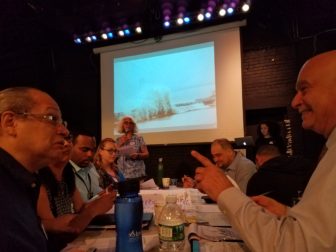“This is stuff that really needed to have happened the first or second day,” a resident observed. It felt like maybe, as the storm bore down, it was too late for new ideas.
Fortunately, Jesse never happened. It was a storm simulation conjured for a table-top planning exercise on October 23 at The Point, a community based organization that champions economic development and opportunities for Hunts Point’s young residents. New York City Environmental Justice Alliance, Nos Quedamos, Youth Ministries for Peace and Justice, Mothers on the Move and Sustainable South Bronx were among the organizers and participants.
The exercise highlighted how climate-related natural disaster poses the latest threat to a neighborhood long-plagued by hazardous industrial practices and community disinvestment. The peninsula is laced with contaminants left over from a ConEdison coal station and thousands of idling trucks have contributed to one of the highest rates of asthma in the country.

Jarrett Murphy
Bronx nonprofit and businesses leaders and area residents take part in a hurricane response drill earlier this week at The Point CDC in Hunts Point.
Therefore, Hunts Point residents have taken an active role in planning the resiliency projects that will affect the community and potentially mediate some of the environmental hazards. The City has encouraged such involvement, facilitating regular meetings with community activists.
“People talk about resiliency, but for us, it’s not only about physical infrastructure,” says Angela Tovar, director of community development at The Point. “It’s ensuring that people in Hunts Point, where there are public health issues like asthma, diabetes and heart disease, are protected.”
In 2014, the federal government allocated $20 million in Community Development Block Grant Disaster Recovery (CDBGDR) funds to specifically pay for resiliency efforts at Hunts Point. The City then pledged an additional $25 million from its multi-billion dollar CDBGDR pool.
The $45 million has been used to fund two feasibility studies, to organize community engagement sessions with Hunts Point residents and to begin the development of an energy resiliency pilot project based on recommendations by an architectural firm selected by the Department of Housing and Urban Development (HUD).
The funding expires in 2022 so NYCEDC says it plans to break ground on the pilot project by 2020 after completing environmental assessments, a request for proposals process and other requirements. A timeline included in an April 2017 action plan by the Mayor’s Office of Recovery and Resiliency—approved by HUD in August— lists a Summer 2022 completion date.
In late-2013, HUD funded 10 projects collectively titled “Rebuild by Design” to improve resiliency measures at coastal locations vulnerable to flooding, including Hunts Point. HUD then commissioned an architectural firm to develop strategies for securing the Hunts Point peninsula against flood.
The firm unveiled four ideal, comprehensive strategies, which they called Hunts Point Lifelines. The Lifelines include building levees along the coastline and integrating the flood barriers into a long-imagined plan for a South Bronx Greenway that would provide residents with access to the shoreline. They also proposed building a microgrid to supply power to the food distribution center and called for hiring local community members to develop the new infrastructure. The firm estimated the first phase of development—including building levees around 3.1 miles of the city-owned Hunts Point shoreline—would cost more than $800 million.
NYCEDC says the goal of these resiliency efforts is to develop a system for storing three-days worth of power to the food distribution center because food, on average, moves in and out of the markets within three days.
The action plan proposes the installation of solar panels and storage batteries on the roofs of two local public schools —P.S. 48 and M.S. 424. When contacted earlier this month, the principal at PS 48 told City Limits he did not know about solar panels on the building roof. A woman who answered the phone at MS 424’s administrative office also said she has never heard of a solar panel project at the school.
Tovar says the city has not yet held a public information session since the plan’s approval in August.
As planning proceeds, Tovar says she would like to see continued efforts to secure the shoreline and create energy sustainability in addition to the modest pilot project.
“I understand that a lot of the emphasis on resiliency went to neighborhoods that were impacted first and rightfully so,” she says. “Those communities endured a lot of damage and heartache and suffered greatly because of Sandy.
“It’s important to understand the next storm is not going to have the same trajectory,” she continues. It could hit other vulnerable low-lying areas and the city needs to think about how it can fast track some of these projects in a way that’s meaningful and thinks of community as a whole.”









One thought on “Spared by Sandy, City’s Waterfront Food Hub Prepares for Future Disasters”
Pingback: Hunts Point Distribution Center: A Brief Overview with a Spotlight on the Produce Market - NYC Food Policy CenterNYC Food Policy Center